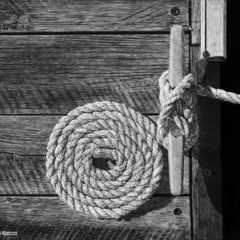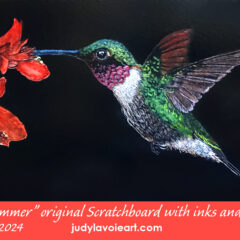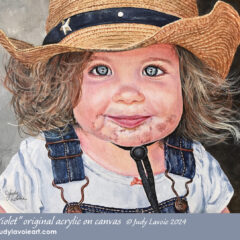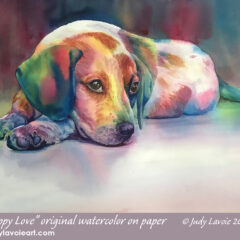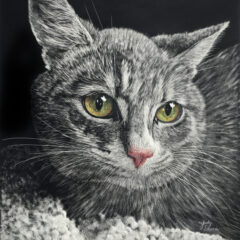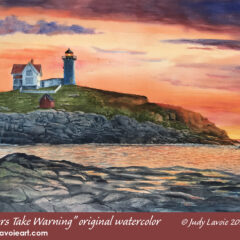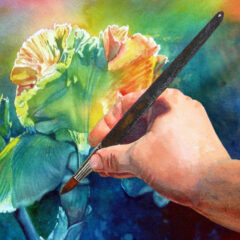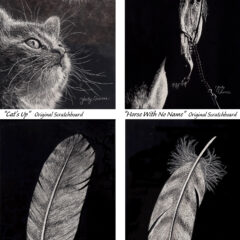 |
| Sleeping Ginger © Judy Lavoie 1997 |
I generally create my watercolor paintings on heavyweight (300lb.) watercolor paper, often using a knife blade and other abrasives to reveal some white paper below, so Aquabord seemed a natural for me. But before I started a new painting on Aquabord, I was looking for tips on the website of the manufacturer, Ampersand. To my surprise I discovered that “Aquabord” was formerly called “Claybord™ Textured” – an art surface I had used over 20 years ago! My first use of Clayboard was “Sleeping Ginger,” a portrait of my beloved English Springer Spaniel painted in 1997 with black ink. I loved how I was able to scratch down to white for details like the whiskers and wet nose, rub away with steel wool for a soft edge as on Ginger’s white fur and reflection, and etch off some ink then glaze to create the textures of fur.
 |
| Her Highness © Judy Lavoie 1998 |
The following year, I used watercolors on Claybord Smooth to create “Her Highness.” The unique properties of Claybord allowed me to wipe away pigment to create light blades of grass overlapping the lioness, and scratch out fine fur, whiskers, and white highlights on her eyes. I did a few more scratchboard paintings, including some using acrylic paints, before I moved on. I’m not really sure why I abandoned it!?!?
I looked through my reference photos to determine what might be some fun new paintings to try on the 7″x5″ Aquabord panels. Since I’ve been painting all my recent watercolors with limited color palettes, I challenged myself to create two new paintings of very different subjects using just 3 primary colors. In this case, I used American Journey Sour Lemon (Hansa), Rambling Rose, and Joe’s Blue (Phthalo), the house-brand from Cheap Joe’s Art Stuff. I used a small round mixing palette set up like a color wheel, with the center for mixing all three colors. I had previously done a mixing study with these pigments, so I knew I could get clean, non-muddy mixes and a good range of hues. I also pulled out my box of scratching and etching tools, which had been gathering dust among my art supplies.
I decided to paint a little landscape of the upper Tellico River as it tumbles over rocks in the Cherokee National Forest, here in SE Tennessee. I liked the way the bright sunlight highlighted tree branches and how the moving water sparkled – ideal for revealing the white clay below my paints. The collage below shows the Aquabord panel with the painted image on the left, and the panel after I revealed some of the white clay in the center. In some places, like in the grass in the foreground, I did a transparent glaze of paint over the scratched-out blades of grass to make them light green. “Up The Tellico” is a much smaller painting than I usually do, and it was fun and quick to create. I was ready for more.
 |
| Up The Tellico © Judy Lavoie 2018 |
 Once completed, a watercolor painting on Aquabord can be sprayed with a clear acrylic. Krylon UV archival spray was recommended and worked well on these. With the paints sealed they are waterproof and the surface of the panel can be safely cleaned with a damp rag. No matting, no glass – yeah!
Once completed, a watercolor painting on Aquabord can be sprayed with a clear acrylic. Krylon UV archival spray was recommended and worked well on these. With the paints sealed they are waterproof and the surface of the panel can be safely cleaned with a damp rag. No matting, no glass – yeah!
I’m anxious to continue my Aquabord experiments, so you’ll be seeing more soon. I have a small Claybord Black panel begging to be used!



